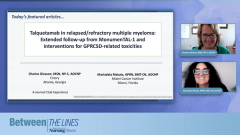
Introducing GPRC5D and MonumenTAL-1 Trial for R/R Multiple Myeloma
Panelists discuss the growing promise of GPRC5D-targeted therapy in relapsed/refractory multiple myeloma, highlighting MonumenTAL-1 trial data showing encouraging responses in heavily pretreated patients and emphasizing the importance of managing unique keratin-related and neurologic toxicities linked to GPRC5D expression.
Episodes in this series

GPRC5D is a target of growing interest in multiple myeloma therapy. It’s a G protein–coupled receptor expressed broadly on plasma cells—especially malignant ones—and also on keratin-producing cells such as those in hair follicles, nails, and the tongue. This expression pattern quickly became clinically relevant, as early trial participants experienced adverse effects localized to those keratin-rich areas, including tongue lesions and nail changes. GPRC5D is also found in the inferior olivary nucleus of the medulla oblongata, a region responsible for relaying motor and sensory information, which may help explain some of the neurologic adverse effects reported, such as immune effector cell–associated neurotoxicity syndrome.
The MonumenTAL-1 trial evaluated a GPRC5D-targeting bispecific antibody in patients with relapsed/refractory multiple myeloma who had received at least 3 prior lines of therapy, including a proteasome inhibitor, an immunomodulatory drug, and an anti-CD38 monoclonal antibody. Participants needed to have good performance status and documented disease progression. The trial tested 2 dosing strategies: 0.4 mg/kg subcutaneously every week and 0.8 mg/kg every 2 weeks. Importantly, the study included patients both naive to and previously exposed to T-cell–redirecting therapies like CAR T cells or other bispecifics.
The primary goal was to assess overall response rate, with secondary end points including duration of response, progression-free survival, and overall survival. The inclusion of patients previously treated with T-cell redirection reflects the real-world complexity of heavily pretreated myeloma populations. Early findings suggest that GPRC5D-directed bispecifics may offer a viable treatment option even in those with prior exposure to similar immunotherapies. As more data emerges, the hope is that these agents will not only extend survival but also provide better quality of life through manageable adverse effect profiles and flexible dosing options.
Newsletter
Knowledge is power. Don’t miss the most recent breakthroughs in cancer care.


















































































